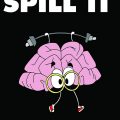Push Play for ‘Moojic’

Here’s presenting Moojic, an in-store radio service.
Neha Behani and Kumaran Mahendran quit their lucrative jobs in 2011 to start something they were passionate about and that passion was mobile, music, and everything in between. The crux of their dream lay in the idea of convergence of Social, Local, and Mobile (SoLoMo). Their dream-turned-reality, Moojic is an in-store radio service - similar to a jukebox - for restaurants, cafes, salons, bars, gyms, and other retail outlets where customers can interact with the playlists. Our correspondent goes along on their dream musical journey.
Great ideas lead to awesome businesses - When and how did your idea translate into a great business module?
I disagree with that statement. Great ideas remain great ideas. Rather, focus on great execution and the fundamentals of running a business lead to an awesome business. We learnt this the hard way, too. When we first started, we firmly believed that a great idea automatically ensured an amazing business and that the business model would present itself. Moojic, as it is today, is actually our third business model after two full pivots around previous business models.
The idea for Moojic popped when we had some time to kill at a café while waiting for a meeting. Since we were insanely curious about how mobile and mobile applications were going to define new age business models and be the customer touch point of choice, we spent time observing people who were waiting. That led to us thinking about old-school jukeboxes at restaurants and cafes which allows customers to select songs after inserting a coin. We wondered how we could get this to work from a mobile phone application. The more we spoke about this idea, the more we truly believed that this was a game changing idea and would lead to an amazing business model. Over time, we realized that customers in Indian markets wouldn’t pay for a service such as this and we had to figure out a way to monetize the business. We added other avenues to the business and created a robust technology platform with an ability to deliver a seamless in-store radio experience for retail brands. Once we got to this point, the business model evolved and after a year of working with a limited set of clientele and understanding their requirements, we have scaled to managing over 3500 retail stores across 6 countries.
Offering music as a service could be quite challenging, what’s the difference between the deliverables then and now?
The deliverables remain the same – being able to provide a seamless assortment of content that goes with the values of the retail brand. The delivery mechanism is what has changed. Earlier, brands used to manage their in-store music with CDs that were sent across to their multiple stores periodically and had to assign someone in their team to manage the logistics of the same. What usually happened is that after a while, either the music would become repetitive at the store or the store staff would begin to play their own music and it could lead to dilution of the brand’s value as the music played may not go along with the brand attributes. Our platform ensures that content delivery is seamless stays true to the brand’s attributes. For this we carry out an extensive study on the brand and create a sonic identity. The platform automates a lot of what was earlier a manual task and also ensures that front line staff at stores aren’t able to play any other music at the store.
When the right talent is inducted everything goes right! What’s your induction process like? How does your company identify, select, and recruit talent?
Great teams make great companies. We take a lot of time before we include someone into our team. We prioritize references and have mostly refrained from using Executive Search firms for our hiring process. We prefer to take our time to identify the right person not just for the job but also for the culture of the company as well. A few mistakes we have made in the past have taught us that it’s better to wait for the right person than to try and make do with the wrong person. We also give a lot of weightage to character and a person’s inclination to learn. We strongly believe that as long as a person is willing to learn and go the extra mile – skills can be developed. It is the initiative that makes the difference.
Decisions can be game-changers, for better or for worse. At Moojic, what are the processes followed in making decisions?
More often than not the only advantage a startup has against larger established players is the ability to quickly evolve, pivot, react, and deliver. In order to be able to do this, decisions need to be made quickly. And the process of making decisions must be simple. Our decision-making process usually involves a quick meeting with most of our team where we bounce off ideas and gauge how people respond to the idea. We usually make up our minds on what we want to do then and there, and start working on it. Being a smaller team also helps us to be quick, without holding on to much baggage.
If innovation is the mother of sustenance, what are your strategies to sustain Moojic? Could you give us a few examples?
Innovation is very crucial to long-term sustenance and we ensure that we are constantly working on adding functionality and improvements to our platform. The best way of doing this after acquiring a sizeable clientele is to constantly listen to your customers. One of the ways we act on our customer feedback is by sharing that particular feedback with other customers, too. If we find that it is more or less a common pain point, we usually work to add or change functionality to resolve that pain point. This constant evolution of the product ensures that we are able to service a large set of customers and helps to scale the business easily. An example of how we improved our platform over a year is with our customer care support channels. There was a time when we would get around 8 to 10 issues a day through our various support channels. And at that time our customer base was a little over 400 stores. We studied the data from our CRM and identified the common issues and after ranking the frequency of issues, we set out to either fix those issues or remove the reason for those issues from our platform. A year later, we have over 2000 stores and we receive only a maximum of 3 to 4 issues a week!
Let’s talk about funding - was the company started on pre-seeding funding basis? How are the investments being managed to scale the start-up to the next level?
The company was initially bootstrapped with funds of our own. We raised an angel round of 30 Lakh Rupees initially that helped us get our technology team in place. Post that, we raised a seed round of Rs 2 crore that helped us scale our platform. Today, we are a cash flow-positive company and we are looking to scale internationally. We are also aiming to grow as the largest in-store radio platform in the world.
Startups and crises go hand-in-hand. What does your team do to resolve crises? Care to share a few troubleshooting tricks?
Yes, most startups do deal with a crisis every other day. This is particularly because most of us do not have strong processes in place, hence we end up fighting fires very often. But over time, what we have learnt is that there is never really a crisis that can’t be solved and that more often than not it is the more difficult decision that solves the issue permanently. Living on short term fixes usually leads to a much larger issue in the future and you only land up delaying a much larger crisis. We usually whiteboard the issues at hand and the possible solutions and make up our minds on the best way to move forward. Sometimes your gut tells you what needs to be done, and even if it sometimes needs you to take an unpleasant decision, the quicker you do it the faster you will recover from the crisis.
If you were to sell your company what would be the tone and the pitch for your negotiations?
Being a cash-positive company has its advantages beyond the cash we generate on a monthly basis, it buys us time in negotiations. A hurried negotiation usually works out to the advantage of a potential buyer. We know for a fact that every quarter that we get will also get us more clients, more revenues and more profitability which eventually leads to a better valuation as well. We would definitely waituntil we believe we have an offer that matches the value that the organization has today and takes into account the growth potential of the platform as well.
Shall we talk about failure?
Fear of failure usually leads to failure. We acknowledge that there is a possibility of our company failing but we don’t bow down to it, and despite any crisis that comes across bringing us to our knees, we power forward. Also, with experience, we have begun planning for contingencies.These are exactly the kind of situations in which having the right team makes a world of difference. When the entire team works together to get us through a crisis, this can not just get us out of the “failure-like” situation but also motivate us to move forward at an amazing speed. We usually come out of such situations stronger and closer as a team and as a company.
How has your experience been with in-store radio services in our country? Please share your views.










